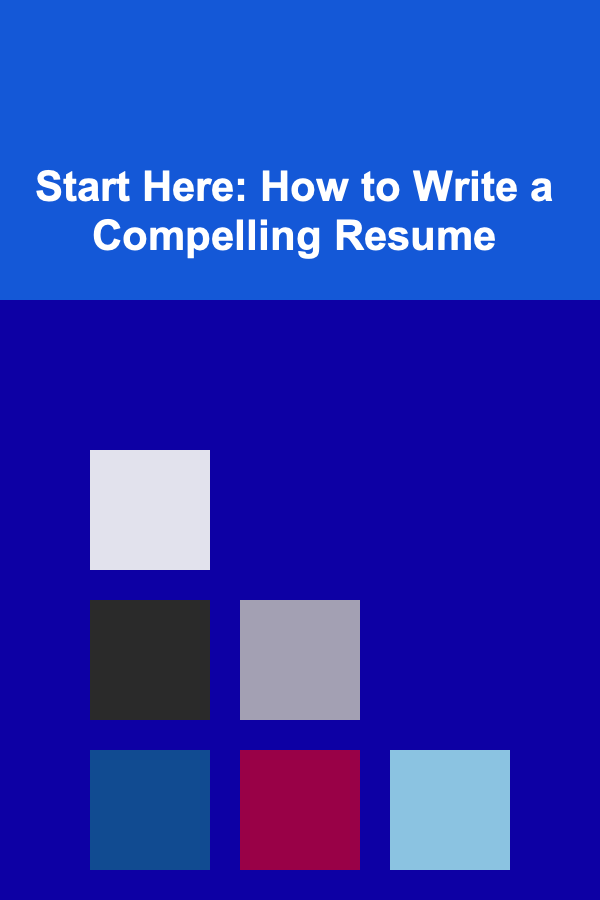
Start Here: How to Write a Compelling Resume
ebook include PDF & Audio bundle (Micro Guide)
$12.99$7.99
Limited Time Offer! Order within the next:

A resume is your personal marketing document---a snapshot of your career, skills, and experiences. Whether you're applying for a new job, seeking a promotion, or trying to switch industries, a well-crafted resume can make all the difference in getting noticed by hiring managers and recruiters. But creating a compelling resume isn't as simple as listing your job history. It involves strategically highlighting your strengths, aligning your experience with the employer's needs, and presenting yourself in a way that captures attention quickly.
In this actionable guide, we will break down the essential components of writing a resume that stands out. We'll cover everything from understanding your audience to optimizing your resume for Applicant Tracking Systems (ATS), so that you can confidently submit your resume and increase your chances of landing your dream job.
Know Your Audience
Before you start writing, it's crucial to understand who will be reading your resume. A hiring manager or recruiter typically spends only about 6-7 seconds reviewing a resume at first glance, so you must grab their attention quickly.
Consider the Employer's Needs
- Job Description Analysis: Start by closely reading the job description. Highlight the key skills, qualifications, and responsibilities mentioned in the listing. Tailor your resume to showcase how your experience aligns with these requirements. Employers want to see that you understand the role and are capable of performing the tasks outlined.
- Industry Expectations: Different industries and job roles have different expectations for resumes. For example, a resume for a graphic designer will differ vastly from that of a software engineer. Understanding the norms in your field will help you present yourself effectively.
- Company Culture: Research the company's values and culture. For example, a startup may appreciate a creative, unconventional resume, while a corporate entity may prefer a more formal and structured one. Reflecting the company's ethos in your resume can help you make a better connection.
Choose the Right Resume Format
The format of your resume plays a significant role in how it's perceived. There are three main types of resume formats, and each is suited for different job situations.
1. Chronological Resume Format
The chronological resume is the most common format and emphasizes a clear, structured work history. This format is ideal if you have a solid, consistent career path within one industry and want to show a direct progression of your skills and experience.
- Structure: This format lists your most recent job first, followed by your previous positions in reverse chronological order.
- Use it if: You have strong work history and want to show growth in a specific career.
2. Functional Resume Format
The functional resume focuses more on skills and achievements than on your chronological work experience. It highlights what you can do rather than when you did it.
- Structure: This format lists your skills and accomplishments first, followed by a brief employment history. It's great for candidates with gaps in their work history or those transitioning to a new field.
- Use it if: You're changing careers, have gaps in your employment, or want to highlight a specific set of skills.
3. Combination Resume Format
As the name suggests, the combination format merges elements of both the chronological and functional resumes. It highlights your skills and qualifications upfront but also includes a brief section on your work history.
- Structure: The skills and accomplishments section comes first, followed by your work experience in reverse chronological order.
- Use it if: You want to emphasize both your skills and work experience. This format is great for candidates who have a lot of experience but also want to showcase their diverse skill set.
Craft a Powerful Resume Summary or Objective
The resume summary or objective is the first thing an employer sees, so it's essential to make it compelling. A strong summary will entice the reader to continue.
Resume Summary
A resume summary is a concise paragraph that highlights your professional background, key achievements, and skills. It is best suited for those with substantial experience or a well-defined career path.
- Keep it short: Aim for 2-3 lines that sum up your expertise and what you bring to the role.
- Highlight your value: Focus on what you've accomplished and how it relates to the job you're applying for.
Example :
"Experienced digital marketing specialist with over 5 years of expertise in SEO, content marketing, and PPC advertising. Proven track record of increasing website traffic and improving conversion rates by over 30%. Adept at creating data-driven campaigns to drive business growth."
Resume Objective
A resume objective is a statement of your career goals and what you hope to achieve in your next job. This is most beneficial for entry-level candidates or those transitioning careers.
- Focus on the employer's needs: Make sure your objective conveys what you want to achieve for the company, not just what you want from the job.
- Be clear and concise: Keep it focused on your aspirations and how they align with the company's goals.
Example :
"Motivated and results-driven recent graduate seeking a marketing position where I can utilize my analytical skills and creative abilities to drive business success and contribute to the company's growth."
Showcase Relevant Experience
Your work experience section is one of the most important parts of your resume. Here, you need to showcase not only where you've worked but also what you've accomplished.
Job Descriptions and Accomplishments
When describing each role, focus on results rather than duties. Instead of simply listing tasks, explain how your actions led to improvements, increased efficiency, or growth for the company.
- Use quantifiable achievements: Whenever possible, back up your accomplishments with numbers (e.g., "Increased sales by 20% in the first quarter").
- Use action verbs: Start each bullet point with an action verb like "led," "designed," "implemented," or "improved" to demonstrate your active role in the outcomes.
Example:
- Sales Manager | XYZ Corp | June 2017 - Present
- Led a team of 10 sales professionals, surpassing sales goals by 25% each quarter.
- Developed and executed a sales strategy that increased revenue by $2M annually.
- Trained and mentored junior sales staff, improving team performance and retention rates.
Tailor Your Experience to the Job
When applying for a specific position, ensure that the experience you highlight is directly related to the job requirements. Customize your resume for each job by adjusting the job descriptions and keywords to match what the employer is seeking.
Highlight Your Skills and Certifications
Employers look for specific skills that are relevant to the job you're applying for. Create a dedicated skills section to showcase your core competencies. This is also where you can list any certifications or courses you've completed.
Technical Skills vs. Soft Skills
- Technical skills: Include tools, software, and systems you're proficient in, such as CRM software, project management tools, or programming languages.
- Soft skills: Highlight qualities such as communication, leadership, and problem-solving, which can add value to the job beyond technical expertise.
Certifications and Courses
If you have certifications that are relevant to the role, be sure to mention them. These can set you apart from other candidates.
Example:
- Certifications
- Google Analytics Certified
- Project Management Professional (PMP)
- AWS Certified Solutions Architect
Optimize for ATS
Many companies use Applicant Tracking Systems (ATS) to filter and rank resumes before they ever reach a human recruiter. To increase the chances of your resume being noticed, ensure that it is ATS-friendly.
How to Optimize for ATS
- Use standard resume headings: Stick to common resume headings like "Experience," "Education," "Skills," and "Certifications" to ensure the ATS can easily identify sections.
- Incorporate relevant keywords: Based on the job description, include relevant keywords and phrases that the ATS may look for. Be specific about your skills and experiences.
- Avoid images and unusual fonts: ATS systems can struggle with parsing images, graphics, and non-standard fonts, so keep your resume simple and text-based.
Polish the Design
While content is king, a clean, easy-to-read design is essential for making your resume stand out visually.
Keep it Simple
Stick to a simple layout with clear headings and bullet points. Use bold or italics for emphasis but avoid over-cluttering your resume with graphics, color, or excessive design elements.
Use White Space Effectively
Leave enough white space to ensure your resume is easy on the eyes. A cluttered resume can overwhelm the reader and make it harder for them to focus on your qualifications.
Choose Readable Fonts
Use professional, readable fonts like Arial, Calibri, or Times New Roman. The font size should be around 10-12 points, ensuring that your resume is legible both on screen and in print.
Proofread and Edit
Finally, proofreading is crucial. A resume full of spelling errors or grammar mistakes gives the impression that you don't care about attention to detail.
- Check for consistency: Ensure your dates, job titles, and formatting are consistent throughout the resume.
- Use a grammar tool: Utilize tools like Grammarly or Hemingway to catch spelling and grammar mistakes.
- Ask for feedback: Have a friend or colleague review your resume to provide fresh eyes and constructive criticism.
Conclusion
Writing a compelling resume involves much more than just listing your job history. It's about strategically highlighting your skills, experiences, and accomplishments in a way that speaks directly to the employer's needs. By tailoring your resume for each job, optimizing it for ATS, and presenting it in a clean, professional design, you can increase your chances of standing out and landing the job you want.
With these actionable tips in mind, you're now ready to craft a resume that will help you take the next step in your career. Good luck!

How to Create a Cozy Reading Nook in Your Bathroom
Read More
How to Manage Property Inspections Without Annoying Your Tenants
Read More
How to Maximize Your Leisure Time by Utilizing Public Parks and Recreational Areas for Free Activities
Read More
How To Shoot Commercial Photography
Read More
Monetizing Your Deep Learning Skills: Passive Income Ideas
Read More
How to Build a Home Studio on a Shoestring
Read MoreOther Products

How to Create a Cozy Reading Nook in Your Bathroom
Read More
How to Manage Property Inspections Without Annoying Your Tenants
Read More
How to Maximize Your Leisure Time by Utilizing Public Parks and Recreational Areas for Free Activities
Read More
How To Shoot Commercial Photography
Read More
Monetizing Your Deep Learning Skills: Passive Income Ideas
Read More